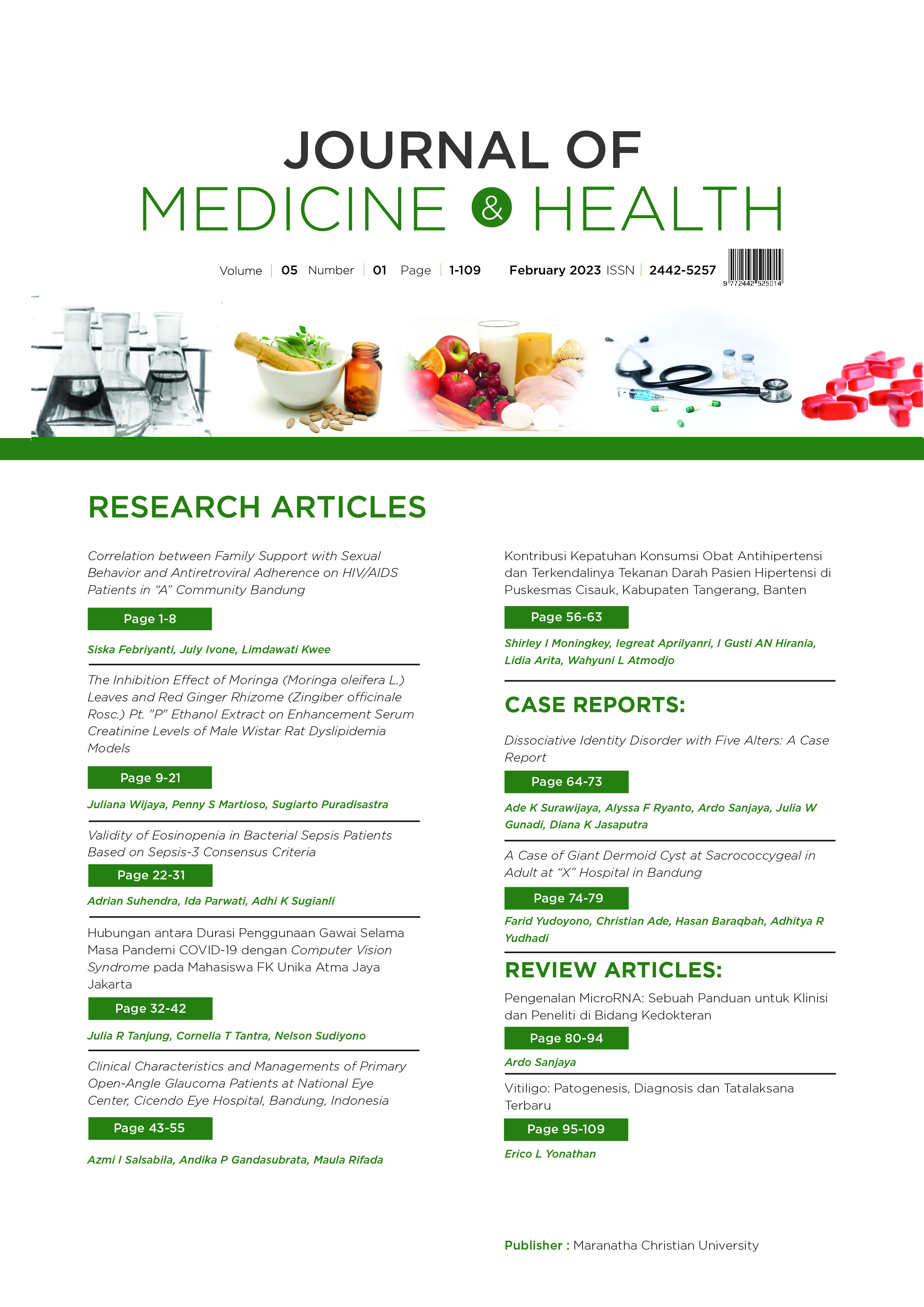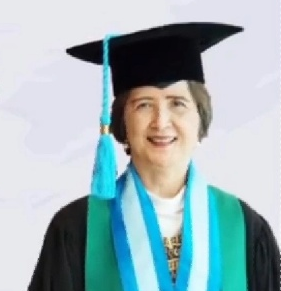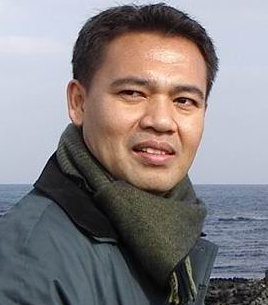Dissociative Identity Disorder with Five Alters: A Case Report
DOI:
https://doi.org/10.28932/jmh.v5i1.4603Keywords:
dissociative, identity disorder, multipleAbstract
Dissociative Identity Disorder (DID) is a complex disorder that stems from repeated trauma during childhood. Although not particularly rare, DID is surrounded by myths and stigma that prevent it from being diagnosed and managed as an authentic mental condition. The purpose of this case report is to present a typical case of DID to raise awareness of and decrease the stigma on DID and to reaffirm that this disorder requires proper treatment. The patient is a 25-year-old male diagnosed with DID and had five alters consisting of: two protectors, a prosecutor, a suicidal alter, a child alter, and one debatable female alter. He was given psychoeducation without any oral treatment as the second alter was not open to any treatment that could make the female – either a hallucination or an alter – disappear. In contrast to media portrayals and myths about DID, the patient did not in fact have any supernatural powers nor commit any crimes. He also had distinctive manifestations of DID that were in accordance with the diagnostic criteria of DID. The conclusion of the case report is that DID in the patient is a true diagnosis, and the treatment should be done regardless of any myths and stigma in society.Downloads
References
Mitra P, Jain A. Dissociative Identity Disorder. In: StatPearls [Internet] [Internet]. Treasure Island: StatPearls Publishing; 2021. Available from: https://www.ncbi.nlm.nih.gov/books/NBK568768/
Sar V, Dorahy M, Krüger C. Revisiting the etiological aspects of dissociative identity disorder: a biopsychosocial perspective. Psychol Res Behav Manag [Internet]. 2017 May; Volume 10:137–46. Available from: https://www.dovepress.com/revisiting-the-etiological-aspects-of-dissociative-identity-disorder-a-peer-reviewed-article-PRBM
Paris J. The Rise and Fall of Dissociative Identity Disorder. J Nerv Ment Dis [Internet]. 2012 Dec;200(12):1076–9. Available from: https://journals.lww.com/00005053-201212000-00013
Brand BL, Sar V, Stavropoulos P, Krüger C, Korzekwa M, Martínez-Taboas A, et al. Separating Fact from Fiction: An Empirical Examination of Six Myths About Dissociative Identity Disorder. Harv Rev Psychiatry [Internet]. 2016;24(4):257–70. Available from: https://www.ncbi.nlm.nih.gov/pmc/articles/PMC4959824/
Loewenstein RJ. Dissociation debates: everything you know is wrong. Dialogues Clin Neurosci [Internet]. 2018 Sep 30;20(3):229–42. Available from: https://www.tandfonline.com/doi/full/10.31887/DCNS.2018.20.3/rloewenstein
Split [Internet]. IMDb. 2016 [cited 2021 Oct 25]. Available from: https://www.imdb.com/title/tt4972582/?ref_=tt_sims_tt_i_1
Mitra P, Jain A. Dissociative Identity Disorder. In: StatPearls [Internet] [Internet]. Treasure Island: StatPearls Publishing; 2021. Available from: https://www.ncbi.nlm.nih.gov/books/NBK568768/
Sar V, Dorahy M, Krüger C. Revisiting the etiological aspects of dissociative identity disorder: a biopsychosocial perspective. Psychol Res Behav Manag [Internet]. 2017 May;Volume 10:137–46. Available from: https://www.dovepress.com/revisiting-the-etiological-aspects-of-dissociative-identity-disorder-a-peer-reviewed-article-PRBM
Paris J. The Rise and Fall of Dissociative Identity Disorder. J Nerv Ment Dis [Internet]. 2012 Dec;200(12):1076–9. Available from: https://journals.lww.com/00005053-201212000-00013
Brand BL, Sar V, Stavropoulos P, Krüger C, Korzekwa M, Martínez-Taboas A, et al. Separating Fact from Fiction: An Empirical Examination of Six Myths About Dissociative Identity Disorder. Harv Rev Psychiatry [Internet]. 2016;24(4):257–70. Available from: https://www.ncbi.nlm.nih.gov/pmc/articles/PMC4959824/
Loewenstein RJ. Dissociation debates: everything you know is wrong. Dialogues Clin Neurosci [Internet]. 2018 Sep 30;20(3):229–42. Available from: https://www.tandfonline.com/doi/full/10.31887/DCNS.2018.20.3/rloewenstein
Split [Internet]. IMDb. 2016 [cited 2021 Oct 25]. Available from: https://www.imdb.com/title/tt4972582/?ref_=tt_sims_tt_i_1
Dorahy MJ, Brand BL, Sar V, Kruger C, Stavropoulos P, Martinez-Taboas A, et al. Dissociative identity disorder: An empirical overview. Aust New Zeal J Psychiatry [Internet]. 2014 May 1;48(5):402–17. Available from: http://journals.sagepub.com/doi/10.1177/0004867414527523
Nester MS, Hawkins SL, Brand BL. Barriers to accessing and continuing mental health treatment among individuals with dissociative symptoms. Eur J Psychotraumatol [Internet]. 2022 Jul 29;13(1). Available from: https://www.tandfonline.com/doi/full/10.1080/20008198.2022.2031594
van der Hart O, Lierens R, Goodwin J. Jeanne Fery: a sixteenth-century case of dissociative identity disorder. J Psychohist [Internet]. 1996;24(1):18–35. Available from: http://www.ncbi.nlm.nih.gov/pubmed/11616278
Faure H, Kersten J, Koopman D, Hart O van der. THE 19th CENTURY DID CASE OF LOUIS VIVET: NEW FINDINGS AND RE-EVALUATION. DISSOCIATION. 1997;X(2):104–13.
Dorahy M, Mohan I. Dissociative disorders and somatic symptoms and related disorders. In: Abnormal Psychology in Context [Internet]. Cambridge University Press; 2018. p. 154–74. Available from: https://www.cambridge.org/highereducation/books/abnormal-psychology-in-context/9FEDA56666E451DC0279DF47C80AFDFD?chapterId=CBO9781316182444A027#contents
Association AP. Diagnostic and Statistical Manual of Mental Disorders Fifth Edition (DSM-5). 5th ed. Washington DC: American Psychiatric Publishing; 2013. 291–307 p.
Schimmenti A. Elena: A case of dissociative identity disorder from the 1920s. Bull Menninger Clin [Internet]. 2017 Sep;81(3):281–98. Available from: http://guilfordjournals.com/doi/10.1521/bumc_2017_81_08
Vannikov-Lugassi M, Soffer-Dudek N. No Time Like the Present: Thinking About the Past and the Future Is Related to State Dissociation Among Individuals With High Levels of Psychopathological Symptoms. Front Psychol [Internet]. 2018 Dec 7;9. Available from: https://www.frontiersin.org/article/10.3389/fpsyg.2018.02465/full
Kluft RP. An overview of the psychotherapy of dissociative identity disorder. Am J Psychother [Internet]. 1999;53(3):289–319. Available from: https://pubmed.ncbi.nlm.nih.gov/10586296/
Sar V. Formation and Functions of Alter Personalities in Dissociative Identity Disorder: A Theoretical and Clinical Elaboration. J Psychol Clin Psychiatry [Internet]. 2016 Dec 7;6(6). Available from: https://medcraveonline.com/JPCPY/formation-and-functions-of-alter-personalities-in-dissociative-identity-disorder-a-theoretical-and-clinical-elaboration.html
Rehan MA, Kuppa A, Ahuja A, Khalid S, Patel N, Budi Cardi FS, et al. A Strange Case of Dissociative Identity Disorder: Are There Any Triggers? Cureus. 2018;10(7).
Moskowitz A. The Haunted Self: Structural Dissociation and the Treatment of Chronic Traumatization. By Onnovan der Hart, Ellert R. S. Nijenhuis & Kathy Steele. W.W. Norton. 2006.416pp. $32.00 (hb). ISBN 0393704017. Br J Psychiatry [Internet]. 2007 Dec 2;191(6):571–2. Available from: https://www.cambridge.org/core/product/identifier/S0007125000247867/type/journal_article
Urbina TM, May T, Hastings M. Navigating Undiagnosed Dissociative Identity Disorder in the Inpatient Setting: A Case Report. J Am Psychiatr Nurses Assoc [Internet]. 2017 May 2;23(3):223–9. Available from: http://journals.sagepub.com/doi/10.1177/1078390317705448
International Society for the Study. Guidelines for Treating Dissociative Identity Disorder in Adults, Third Revision. J Trauma Dissociation [Internet]. 2011 Feb 28;12(2):115–87. Available from: https://www.tandfonline.com/doi/full/10.1080/15299732.2011.537247
Subramanyam A, Somaiya M, Shankar S, Nasirabadi M, Shah H, Paul I, et al. Psychological Interventions for Dissociative disorders. Indian J Psychiatry [Internet]. 2020;62(8):280. Available from: https://journals.lww.com/10.4103/psychiatry.IndianJPsychiatry_777_19
Downloads
Published
How to Cite
Issue
Section
License
Copyright (c) 2023 Ade K Surawijaya, Alyssa F Ryanto, Ardo Sanjaya, Julia W Gunadi, Diana K Jasaputra

This work is licensed under a Creative Commons Attribution-NonCommercial 4.0 International License.
Authors who publish with this journal agree to the following terms:
- Authors retain the copyright and grant the journal right of first publication with the work
simultaneously licensed under a Creative Commons Attribution-NonCommercial 4.0 International License that allows others to share the work with an acknowledgement of the work's authorship and initial publication in this journal. - Authors are able to enter into separate, additional contractual arrangements for the nonexclusive distribution of the journal's published version of the work (e.g., post it to an institutional repository or publish it in a book), with an acknowledgement of its initial publication in this journal.
 This work is licensed under a Creative Commons Attribution-NonCommercial 4.0 International License.
This work is licensed under a Creative Commons Attribution-NonCommercial 4.0 International License.

















